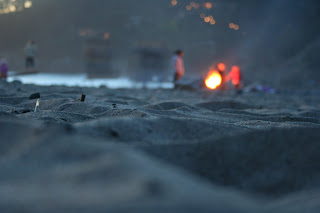
Today we went up to Muir Woods, about 15 miles north according to Google Maps. It's an ancient coastal redwood tree stand, the last 'old forest' in the area.

The story of Muir Woods is the story of an incredibly visionary man, W. Kent, a Congressman, who purchased 611 acres of the woods in 1905 for $45,000. He donated 295 acres to the State in 1907 to thwart the plans of a company who wanted to take possession by court order, so they could dam the creek and flood the valley. He was actually very ahead of his time: when the culture of the day was all about "progress" and "industry", he saw ahead to keep the woods safe for future generations. He reportedly told his wife, who was questioning the expense, "If we lost all the money we have and saved these trees, it would be worthwhile, wouldn't it?"
Theodore Roosevelt, then President, wanted to name the woods after Kent, but he refused, saying that his "five good husky boys" should be able to keep his name alive, or it wasn't worth keeping. He instead asked that they be named after John Muir, who was very pleased. (Unfortunately I can't remember where this part of the story came from!)
In 1945 the United Nations gathered in Muir Woods for (I think) the first-ever meeting - Theodore Roosevelt had died about a month before, who was supposed to open the meeting. Here is the spot where they met: (Yes, it's tiny. I'll bet the fence wasn't there, so that would have made it a lot bigger, but it's still really small.)

Here is the commemorative plaque on the other side of the grove.

We really enjoyed just pottering around and taking photos. The redwoods are not as big as their Giant Sequoia cousins, but still pretty huge. After a forest fire, they all spring back into life either from a burl (bug lump filled with dormant tree buds) on the side of the tree, or the huge underground root system grows new buds. So many trees which look like several growing close together, are actually one huge tree many centuries old.

The bridges across the stream were pretty - I do wonder if they were made with the wood from here?! In all the parks we've been to so far, the bridges are usually pleasant to look at as well as useful. The sign next to me says, "Help keep the creek clean. Do not throw coins into the water." Not exactly something I would have thought of. I think Kiwis are generally better-schooled in how to appreciate nature - Americans seem to need multiple reminders, an overabundance of trash cans, and fences everywhere. Or maybe the park rangers just don't trust people as well.
Here is a hole in a tree which you can walk into - I love how it's paved for wheelchairs. There were quite a few large trees with holes like these. Forest fires sometimes burn the insides out of the trees., and all the trees we saw had charred areas from a fire last year.

It was also surprisingly quiet for such a small area - the woods absorb sound well. Everything was lined with wooden fences so you c/wouldn't go off the trail. IMost of the trails were very easy and paved with wood or tarseal - perfect for wheelchairs. All around were lots of gorgeous flowers:

Redwood Sorrel


and in white;


As we were leaving, we found a sign by the restrooms:

We're really not sure what that means, because the First Amendment refers to personal freedoms. So does that mean it's the place where you can protest, in a little area about 12 m2, by the restrooms? And if so, doesn't that contradict the idea of the First Amendment anyway? Weird. We asked an American family and they didn't know what it meant, either. (They were from New Orleans, and very nice. They said "y'all" a lot. It's how you can tell who's from the Deep South.)
Afterwards we went down to Muir Beach and had a BBQ (well Brendan did - except the problem with spur of the moment trips is that we forgot the BBQ utensils!) and I made hot tea using the espresso maker. The sunset was gorgeous.


No comments:
Post a Comment